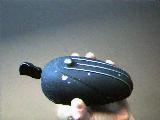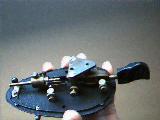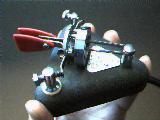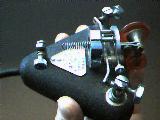Eddystone, the Cedar Rapids Bug, and Cote

The Eddystone Bug
A total of about 400 Eddystone S689 bugs were produced in Birmingham, England in
two production runs in 1947 and 1952. This bug is the only one ever commercially
made in England. It is made of brass and aluminum and the workings are
basically the same as Vibroplex. It has great appeal in that it is one of
only a few bugs ever produced with a cover as an integral part. Colin
Waters, G3TSS, wrote a wonderful article about the Eddystone in "The Vail
Correspondent," No.8, July 1994. Pictured above is the Eddystone with and
without the cover.
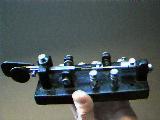
The Cote Bug is a remarkable little gem. It is very sturdily constructed,
works like a charm, and all this on a base only a little over 2" wide!
Only a handful of Cote Bugs are known to exist. The only marking on them is
"O.E. Cote" on the top of the lever arm near the frame. This bug is a bit
of a mystery, as I do not know of anyone who actually knows who O.E. Cote
was!

The Cedar Rapids Speed Key was offered by the Electric Specialty Mfg. Co.
of Cedar Rapids, Iowa. It was made as a kit by George Wilson about 1936,
and is the only bug known which was offered as a kit. The original price
for one was $2.89. Especially since these bugs were built by the buyer, there are
all kinds of variations in color, type of base, circuit closer, etc.
The Cartesian Diver
Descartes (1596-1650), a French philosopher, invented an odd device
which has become known as the Cartesian Diver. It demonstrates the
principles of transmission of pressure by liquids, Archimedes principle,
and the compressibility of gases all in one little toy. A hollow glass
test-tube is filled partly with water and partly with air so that it will just barely float when inverted in
a jar filled with water. By pressing on the green rubber diaphragm at the
top of the jar, the test tube diver sinks or rises at will (thus leading to
the loosely interpreted Descartes quote "I sink therefore I am!". You can
use the sliding bar at the top to press down on the diaphragm on top of
our jar and see how it works. Adapted from A First Course in Physics, by
Milliken and Gale, 1906.
The FYO Keys
It wouldn't be fair to conclude without saying a bit about electronic
keyers and paddles. They really spelled the end of widespread use of the
bug. No paddle in history has been as successful as the Bencher paddle.
The "FYO" paddle invented by Joseph A. Hills (W8FYO) of Dayton, Ohio and offered for
a year or two around 1962 was the prototype. Here you see the iambic model
on the left and the non-iambic version on the right. The presence of a
split ring and the spring arrangement are the only substantial differences
between the two.

I certainly hope you have enjoyed this tour thru history as much as I
did putting it together. . I update this site frequently and appreciate all
comments and suggestions!
Rinus Hellemons PA0BFN 1930
 Back to the Index
Back to the Index


